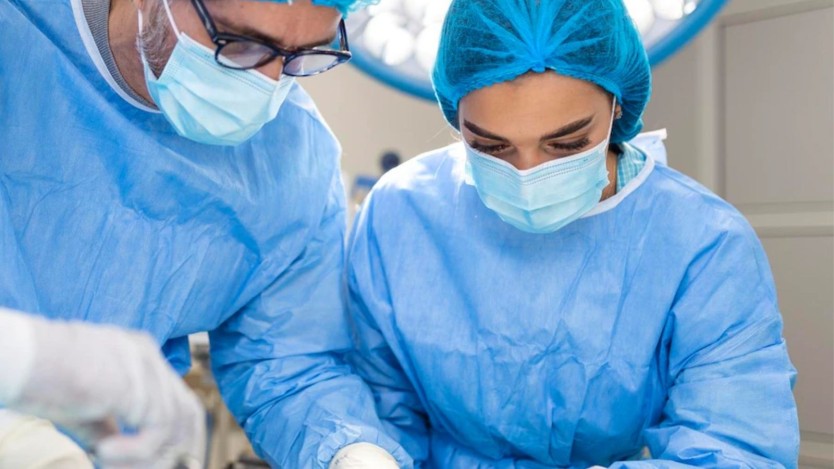What is a strangulated inguinal hernia?

- Facts about strangulated inguinal hernia
- What is an inguinal hernia?
- What is a strangulated inguinal hernia?
- What symptoms does a strangulated inguinal hernia cause?
- How is a strangulated inguinal hernia treated?
- Frequent Questions
Facts about strangulated inguinal hernia
- Strangulated inguinal hernia is an aggravation of a common inguinal hernia that may require emergency repair surgery.
- Strangulated inguinal hernias usually cannot be reduced manually and involve damage to the internal structure because they cannot be reduced.
- Repair of a strangulated inguinal hernia requires either laparoscopic or open surgery.
What is an inguinal hernia?
An inguinal hernia is a pathology consisting of the palpation of a lump by the patient in the groyne region. This lump, which may appear and disappear or remain palpable once it has appeared, is a protrusion or outpouching of contents from inside the abdomen through an orifice formed by the different layers of tissue that form the abdominal wall located, in this case, in the inguinal canal.

Do you need inguinal hernia surgery?
Request a free and immediate appointment with our specialists
An inguinal hernia can be formed by a hernial sac (made up of a layer of intra-abdominal tissue in the form of a pouch) formed inside by part of the abdominal contents, fat, part of the intestine or simply a small outflow of fatty tissue through a defect in the walls of the tissues that form the wall of the abdomen.
An inguinal hernia, by definition, must be located in the inguinal canal. The inguinal canal is an anatomical and virtual area located a few centimetres above the inguinal crease, between the upper part of the pelvis in the direction of the male or female genitalia and the midline of the abdomen.
What is a strangulated inguinal hernia?
There are many types of inguinal hernias depending on the reasons for which they are classified.
If the reason for classifying inguinal hernias is by the type of clinical symptoms they produce, we can find reducible inguinal hernias (those that can be pushed into the abdomen), incoercible inguinal hernias (those that immediately after being introduced manage to come out again through the hernial orifice), incarcerated inguinal hernia (inguinal hernia that cannot be reduced or pushed into the abdomen) and strangulated inguinal hernia (inguinal hernia that cannot be reduced and suffers damage to its internal structure for the same reason).

Therefore, a strangulated inguinal hernia can be defined as the exit of abdominal contents, generally fatty tissue or part of the small intestine, surrounded by a hernia sac through an orifice in the abdominal walls and which suffers damage to the intestinal structures due to compression of the tissues that hinders their vascularisation and can cause ischaemia and subsequent necrosis of the hernia contents.
What symptoms does a strangulated inguinal hernia cause?
The main symptom of strangulated inguinal hernia is moderate pain on palpation of the hernia through the skin. The pain is sharp, prickling and occurs with certain movements or when increasing the strength of the abdominal wall in simple movements such as getting out of bed or the start of walking or running.
The pain of a strangulated inguinal hernia may subside in the first few hours with common painkillers such as paracetamol or ibuprofen, but will continue to grow as the damage to the intestinal tissues that form the inguinal hernia increases.

Do you need to treat a strangulated inguinal hernia?
Request a free and immediate appointment with our specialists in general surgery
In the hours following the onset of a strangulated inguinal hernia there is the possibility of nausea and vomiting in connection with episodes of pain. If the hernia is sufficiently large and agglutinates a significant part of the small intestine, it is possible that intestinal transit may be interrupted, leading to an increase in abdominal girth, a feeling of fullness, difficulty in ingesting food and fluids and even the onset of a low-grade fever.
If the strangulated inguinal hernia continues to develop, it is possible that the tissues that have been trapped in the hernial orifice may suffer significant deterioration, causing intestinal ischaemia that can lead to tissue necrosis and rupture of part of the intestinal contents.

This very serious situation in strangulated inguinal hernia can be extrapolated to other types of hernias in any other location and can undergo the same process as mentioned above. However, strangulated inguinal hernia in such severe stages is infrequent as, nowadays, its diagnosis is usually made in the first few hours, preventing its progression to such severe forms as ischaemia and necrosis of the intestinal tissue.
How is a strangulated inguinal hernia treated?
The treatment of a strangulated inguinal hernia is one of the main indications for emergency surgery in abdominal wall pathologies.
The presence of a strangulated inguinal hernia should be considered a major emergency. Its treatment must be performed in a hospital setting and must be carried out by specialists in general surgery.
The treatment of a strangulated inguinal hernia can be divided mainly into two stages.
The first time of treatment of a strangulated inguinal hernia depends on the period of time from the onset of pain and the onset of symptoms as described above.
If it is only a few hours since the onset of severe pain, it is unlikely that the contents of the hernia sac forming the strangulated inguinal hernia have suffered ischaemic damage, so manual reduction of the hernia will be attempted by the general surgeon after intravenous analgesics to reduce pain.

If this manoeuvre is successful, surgical repair of the inguinal hernia should be performed on a scheduled basis as soon as possible.
If the reduction manoeuvre has not resolved the entrapment of the strangulated inguinal hernia, an urgent surgical intervention must be performed to resolve this pathology.
The second stage of treatment of a strangulated inguinal hernia is performed if several hours have passed since the onset of pain or if the reduction manoeuvres have not been effective. This second stage of treatment involves the resolution of the strangulated inguinal hernia by emergency surgery.
Emergency surgery involves dissection of the abdominal walls until the strangulated inguinal hernia is located and visualised.
Once located, it is usually necessary to dilate the hernial orifice in order to free the hernial bulge from its compression and even, on certain occasions, to increase the diameter of the orifice by cutting it.
Once the hernia has been released from its compression, it is necessary to explore the section of small bowel occluded by the strangulated inguinal hernia for ischaemic damage or signs of necrosis.
If ischaemic damage or necrosis is present, it may be necessary to section the damaged section of bowel and subsequently reattach the two healthy ends. If there has been no necrosis or ischaemic damage, the hernial orifice is closed by suturing (herniorrhaphy) or by placing a protective mesh to occlude the orifice (hernioplasty).
The choice of one method or the other will depend on the characteristics of the hernia, the hernial orifice and the particular characteristics of each patient.

Do you need to treat a strangulated inguinal hernia?
Request a free and immediate appointment with our specialists
Medical disclaimer: All the published content in Operarme is intended to disseminate reliable medical information to the general public, and is reviewed by healthcare professionals. In any case should this information be used to perform a diagnosis, indicate a treatment, or replace the medical assessment of a professional in a face to face consultation. Find more information in the links below:
Frequent Questions
-
What does it feel like to have a strangulated hernia?
The main symptoms and signs of a strangulated hernia are:
- Nausea and/or vomiting
- Fever
- Sudden pain in the area that intensifies rapidly
- Bulging of the hernia that turns red, purplish or dark in colour
- Difficulty in having a bowel movement or passing gas
-
How to treat a strangulated hernia?
The treatment of a strangulated hernia is an emergency surgery. It consists of releasing the herniated tissue and repairing the prolapsed area.
-
Why do hernias occur?
A hernia is caused by a weakening or hole in the peritoneum, the muscular wall that holds the abdominal organs in place.

